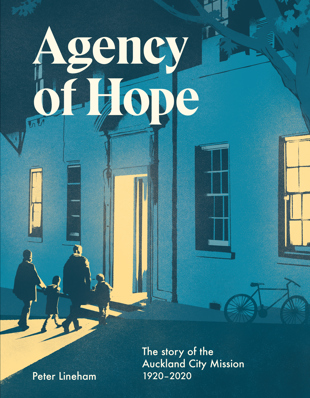Barbara Brookes has reviewed Agency of Hope: The story of the Auckland City Mission 1920–2020 by Peter Lineham for the New Zealand Journal of History:
‘What kind of hope does a city mission offer? To bring people to the hope of belief in God? To bring an end to poverty? To enrich the lives of those living in deprivation? Peter Lineham explores these questions in this beautifully produced book. The design is focused on walking towards a beacon of light, which is an apt metaphor for the aspiration of the Auckland City Mission.
City missions began, Lineham tells us, to rescue the urban poor from sin and squalor in cities such as Glasgow and London. Once the realization struck that heathens were just as readily found in the metropolitan areas of London as in the countries of the world unconquered by Christianity, missioners set out to reform the dens of iniquity at hand. In doing so they also found great need — poverty was as hard to ignore as pickpocketing and prostitution. Presbyterians, Wesleyans, Baptists and the Salvation Army missioned to the urban poor, but not so Anglicans, who remained committed to individual parish responsibility for their own neighbourhoods.
The only place in the world where Anglicans established a city mission was Auckland, in 1920. That innovation was largely due to a colourful and remarkable character, Jasper Calder. Considered by the bishop too outspoken on the need for church reform, and as a rather low character for his delight in horse racing, Calder, although ordained, was unlikely to rise up the Anglican hierarchy. But when he brought forward the idea of a city mission the hierarchy agreed, and he became the city missioner. A man who believed ‘religion was a joyous thing’ (p.36), and who enjoyed sport and dancing, no doubt appealed more to the down and out in Auckland than a deep-thinking theologian. The Auckland City Mission thrived around the cult of this unusual personality, who enjoyed being at the centre of the enterprise.
Mission services, in keeping with Calder’s penchant for acting, began in the Princess Theatre. In this unlikely venue for Anglicans, Calder, accompanied by a 30-strong choir and a musical soloist, drew crowds of working people. Apart from the popular services (which annoyed other vicars), the mission developed outreach through visiting the sick, establishing a hospital library and assisting those at the police court. Assistance was given to all in need, regardless of their religious affiliation.
Collections of food, clothes and furniture were made to deliver to the needy. Guilds of women volunteers sewed clothing, while the Men’s Guild made furniture and toys, and these goods were sold in the mission’s shop. By the 1930s, the enthusiasm for the services had declined, while the need for assistance grew greater, as economic times worsened. In effect, the mission became “primarily a relief agency” (p.54).
In the late 1940s, Canon Caswell decided to refresh the ‘rundown operation’(p.100) by appealing to a wealthy benefactor, Robert James Kerridge, who ran a successful chain of cinemas. Kerridge promised funds and also to show any film the mission produced on the poverty in Auckland. The result was Indictment, produced by Neuline, which can be viewed today on NZ On Screen. The film, which showed elderly people living in squalor, had a huge impact and helped generate the funding for Selwyn Village for the aged.
The themes set in the early chapters — the question of the mission’s relation to the church hierarchy, the need for buildings, money and appropriate staff, and where best to concentrate its energies — are explored through subsequent chapters. We see the various personalities who came with different approaches and ideas, the acquisition and loss of facilities, and the growing professionalization of social work. We also see shifts in focus from a children’s health camp on Waiheke Island, for example, to a respite centre for HIV/AIDS patients.
Any commissioned history must walk a line between paying homage to those who led the organization and the details of its operation and the wider social changes to which it was responding. Lineham does this well, locating the Auckland City Mission in changing government policies, from the evolution of the welfare state to its retrenchment in the 1980s onwards.
Over time, we see an organization responding to the demands of working with the secular state rather than operating a religious body. In 1997, Diane Robertson became the first woman and first lay city missioner, who, by 2000, led a staff of 110 dealing with social work services, fundraising and administration (p.206). Like any big organization, there were tensions amongst personnel who had different objectives. The new climate demanded business plans, performance indicators and a raft of accountability measures that would have been incomprehensible to the likes of Jasper Calder. Lineham charts the changes from a mission spurred by religious zeal to a largely secular social service agency. What is unchanged, he suggests, is the commitment of those involved to make a positive difference and to offer those in need hope for the future.’


